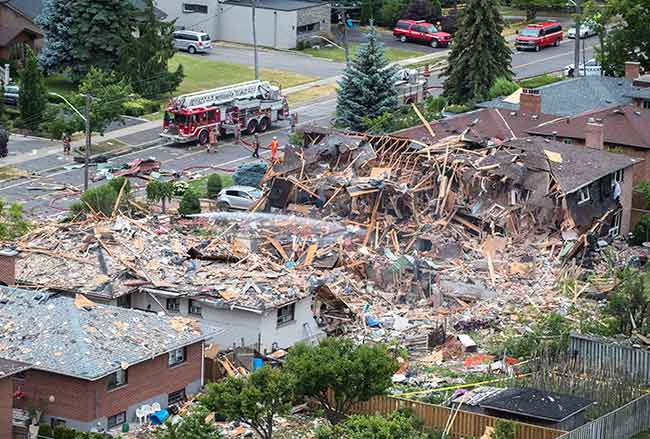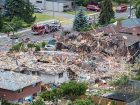
Features
Hot topics
Incident reports
Crisis communication
Mississauga Fire Chief Tim Beckett was on his way home on Tuesday, June 28 – after a day of incident management 300 training – when Deputy Chief Jamie Zimmerman phoned unexpectedly.
August 29, 2016
By
Laura King
 More than 700 addresses were affected by an explosion on June 28 in Mississauga that flattened one home and damaged many others. Rumours of murder-suicide and a meth lab were among the rumours Mississauga Fire Chief Tim Beckett handled after an explosion on June 29.
More than 700 addresses were affected by an explosion on June 28 in Mississauga that flattened one home and damaged many others. Rumours of murder-suicide and a meth lab were among the rumours Mississauga Fire Chief Tim Beckett handled after an explosion on June 29.Zimmerman told Beckett there had been a call for a house explosion that affected four properties; assistant chief Shawn Matheson was on his way to the scene.
Beckett switched on his department radio, heard the description of a massive explosion that had levelled at least one house and damaged others, and turned around.
What happened over 72 hours was eerie and complex – an incident that affected people living at 783 addresses in Canada’s sixth-largest city, a multi-agency response, two fatalities (one a convicted killer), disturbing notes found in the street, rumours of murder-suicide and a meth lab, a full-scale communication strategy, and fire and police investigations.
Under Ontario’s Fire Protection and Prevention Act, explosions are the purview of fire services; Mississauga Fire and Emergency Services (MFES) was the lead responding agency, and Beckett was the overall incident commander.
Communication among agencies, with reporters, and with displaced residents was the critical component that kept a bizarre situation – with myriad media competing for the story behind the story – under control.
***
Beckett’s next call was to Ivana Di Millo, Mississauga’s director of communications. Either Di Millo or a senior communications advisor was at the chief’s side for the duration of the incident, as was, for the most part, a scribe.
The explosion happened at 4201 Hickory Dr., in the heart of a long-established residential neighbourhood on Mississauga’s east side. The home was destroyed, a giant mass of debris. Thirty-seven homes near or adjacent to 4201 had building-code orders placed on them; four were later demolished. Homes up and down Hickory Drive were affected – glass was blown out, garage doors buckled. Windows – and, remarkably, their frames – in a nearby 18-storey apartment building were shattered. Four weeks after the explosion, residents of 37 addresses remained displaced.
No state of emergency was declared. While the explosion was enormous, there was little fire. Eight trucks responded to the two-alarm call.
Beckett arrived at Hickory Drive at about 5:15 p.m. and was briefed by Platoon Chief Al Hills, the operations-sector commander. It was rush hour on Tuesday and reporters from TV networks, all-news radio stations, websites and wire services wanted footage.
For Mayor Bonnie Crombie, elected in November 2014 and successor to Hazel McCallion – who had been Mississauga’s chief magistrate for 36 years – the 4:22 p.m. explosion was her first emergency incident since taking office, and it was important, Becket said, that the mayor have a presence; “She and the local councillor did a great job being there for the residents. We ensure she was part of the media scrums.” Beckett’s rule: never out-media your mayor.
Beckett brought Mayor Crombie to the scene and joined Peel Regional Police at their command post in a mall parking lot. Fire had established its temporary command post nearer the explosion site. By this time, one fatality had been confirmed, but not yet made public. Police Chief Jennifer Evans was on her way to the scene from a conference in Niagara Falls, Ont.
Unified command had been established near Hickory Drive and a more comprehensive command post was later set up at a nearby fire hall.
A communications war room was created at the civic centre at 5:30 p.m.; a community centre was opened to affected residents at 5:45 p.m.
Social media platforms were buzzing with news of the explosion.
***
Having participated in media training through the Ontario Association of Fire Chiefs, Beckett knew it was crucial to manage the message, quash rumours, give reporters clips and quotes, and establish a protocol for information dissemination.
The first press conference was set for 6:15 p.m., in time to make the end of the supper-hour TV news shows.
“I’ve got Shawn working on our messaging with Ivana for the press,” Beckett said. “We briefed the mayor; Chief Evans and I determined that I would lead the press conference because it was a fire event. We worked very closely, and Ivana and the police media person worked very closely. It was about consistency of the messaging and who was going to say what.”
Everything, Beckett said, was scripted. Police, fire and corporate communications agreed what to say, and what not to say.
“It’s about anticipating the questions,” Beckett said. “We know right off the bat that somebody’s going to say ‘What caused this?’ So I actually started it off saying, ‘I know many of you are going to be wanting to know what the cause is. Please don’t ask that question because the answer is going to be the same every time; we don’t know the cause, we’re still in an operational mode.’ And then we never got that question.”
A subsequent press conference was set for 10 p.m. In the meantime, an alerts page was activated on the Mississauga.ca website, and a red banner with information and details for residents was posted. News releases were issued at 7:15 p.m. and 9 p.m.
During the evening, the command post moved to the fire hall.
“We started to work our whole unified command,” Beckett said, “and that was key as far as managing the incident – having that strong unified-command presence where police had all of their people sitting at a table, and fire had all our people sitting at a table, we were able to interact right then and there, and then we brought in building officials, Enersource hydro, Enbridge gas, all our different agencies, a [mapping] person . . .”
Personnel with the Office of Fire Marshal and Emergency Management (OFMEM) arrived on scene led by Jeff Minten, an experienced, media-savvy investigator.
“Any questions to do with the investigation were all going to be answered by Jeff,” Beckett said. “My messaging was really about where the evacuation zones were and what we were doing for the community.
“One of the questions we couldn’t answer at the 6 o’clock news conference was what was the impact on the area; I couldn’t give them numbers of residents but we talked in addresses. The best we could put together was around 700 addresses.”
The next press conference would be at 8 a.m. Wednesday.
***
To ensure consistent messaging, Beckett refrained from tweeting – that was left to corporate communications – although he did retweet some posts. Senior communications advisor Carley Smith said ensuring the same messages came from politicians, city staff, and responders helped to keep residents and reporters on track.
“Every time there was a news release issued we’d develop key messaging to go out on social media,” said Smith.
Hyperlinks in press releases – 12 releases over seven days – were crafted into tweets; city personnel simply clicked the hyperlinks and the tweets appeared in their Twitter feeds.
***
Wednesday morning, the story had new legs: word of handwritten letters found on the street outside 4201 Hickory Dr. declaring financial trouble and a sense of doom had been posted on social media Tuesday evening. And news outlets were reporting that public documents showed the home was owned by 55-year-old Diane Page and her husband, Robert Nadler, 56; Nadler had been convicted of the bludgeoning, strangling and stabbing death of a friend in 1982.
The 8 a.m. news conference would be challenging; even more so with the presence of CP24’s Cam Wooley, a well known, well liked and respected former Ontario Provincial Police sergeant turned reporter.
“He drove a lot of that media conference in terms of the questioning,” Beckett said. “He holds a lot of clout. His big focus was really on the investigation, so Jeff Minten talked about how it was still early and how he was systematically going to be working through things, that it remains an investigation by the fire marshal’s office, because everybody was talking about the fact that this guy was a murderer and asking if it was a meth lab.
“Jeff’s messaging was good: ‘We have no preconceptions of anything because we don’t want to be clouded with that in terms of our judgment, and we’re going to work from the outer perimeter in toward the blast zone.’ ”
On Thursday, June 30, police announced that a second body had been found, but did not identify it as Nadler.
“Thursday at noon we met with police,” Beckett said. “We did a very scripted media scrum where I went in and it was not going to be a free for all, so I walked up and I introduced everybody and I said this is the way this briefing is going to go; I’m going to speak, Mayor Crombie is going to speak, I said we will have the fire marshal’s office speak, and then we’ll have Sgt. Josh Colley speak from the police. We specifically put Josh at the end because there were lots of rumours about [Nadler’s] background and they were going to clarify.
“I remember Josh saying, ‘I do not want to stand there for half an hour answering the same question in the same way,’ so I said, what I’ll do is end up jumping in and controlling who would speak and then indicating the final question.
“I thanked the residents for their patience, co-operation and understanding, all the allied agencies working with us, and then I thanked the media for being good partners, and that started to shift some of the attitudes; it was strategic because I wanted them to continue to respect the privacy of the residents. We were having public meetings with the residents but we weren’t allowing media in. I had said I can’t prevent you from showing up but I don’t want you at the doors. They had their choppers flying overhead and they were up in the apartment buildings.”
Two issues were at play: privacy for the affected residents at the 2 p.m. neighbourhood meeting, and Nadler’s past.
“Peel Police announced that we had the second body [Thursday] and the male deceased was identified on the Friday,” Smith said, “but people were already asking because they knew the house was owned by this guy and this girl, and there were reported letters going around and that’s what Josh was working on, the management of all the rumours and speculation. We left all that up to the police, but it was co-ordinated so we knew what they were going to say and how they were going to approach it.
“Every question [reporters] would ask, everyone would answer the same way so eventually they stopped asking the same question.”
Those messages were critical, Beckett said.
“We made sure we didn’t play into rumours about a meth lab or murder-suicide; we didn’t play into their speculation or necessarily answer their questions; we stuck to the script and our key messaging. Before we went into any press conference there was always key messaging that was developed.”
Still, some reporters showed up at the 2 p.m. community information session; by then, most residents had been allowed back to their homes – 69 addresses remained affected.
“We didn’t hold a press scrum,” Beckett said. “I kicked off that event and left within half an hour while some other people did their thing and I went out and talked to the press and told them this is what’s happening inside, this is what’s going on, so that was a bit of a reward for them for respecting the residents’ privacy and the fact that they weren’t being allowed in.”
***
Keeping residents informed led to a smooth return-home process, but there was more to the strategy.
“The key to some of our success with the public was really about under promising and over delivering,” Beckett said. “If we thought we were going to have people back into their homes Sunday night but didn’t have definitive confirmation on that, we didn’t tell them ‘We think you’ll get back in Sunday night.’ We told them that more than likely we’ll get a hold of you Monday to let you know when we will get you in, so then when we did call them Sunday afternoon and tell them that at 7 o’clock Sunday evening you show up here and we’ll get you back into your home, they were absolutely delighted. We worked hard managing this so that we could get them back early.”
At first, getting in touch with residents was challenging; affected families were asked to register with a police hotline. Cell numbers were also collected at the initial meeting at the community centre, which enabled the use of robocalls for further communication. Later, firefighters went door to door to let others in the neighbourhood know about a community meeting at a nearby school.
***
There were, however, some blips.
Communication with residents of the apartment building in which windows and frames were damaged were inadvertently left out of the loop, and a CityTV reporter caused some headaches.
“This was a key piece that we lost focus on,” Beckett said of the apartment. “The blast came right down an alleyway, there was nothing to prevent it. It came through and went right down and drove right into the middle, and took out windows, not just the panes, the frames – from the second floor right to the 18th.
“Thirty-two residents had prohibited occupancy and we had been told they were being looked after by their condo corp – but we realized on Monday that we had essentially dropped the ball on that piece of communication and we needed to make it right.”
A meeting was scheduled for Monday night, July 4, and Beckett admitted the oversight.
“We knew it could be hostile,” he said, “so the strategy was that I would start to speak and the first comment I made was ‘I owe you an apology, I know that some of you are concerned that we haven’t communicated with you. I know some of you have taken your frustration out on a number of people in this room. None of the people in this room deserve that frustration directed toward them; you direct that frustration toward me, because at the end of the day I had that call to make.’ I owned it, I ate it, and it calmed everybody down.”
Over the next few days, the neighbourhood was divided into zones and residents whose homes were safe were allowed back; others were escorted in to retrieve belongings. Many homes required repairs. Insurance adjusters and building officials were brought on scene.
By Tuesday, July 5 – a week after the explosion – MFES was still holding the scene and reporters were chomping at the bit for fresh footage.
Beckett agreed to meet a CityTV reporter and allow her to take footage near the Hickory Drive command post.
“I get home and I’m watching City and she’s reporting live and she’s standing . . . right here,” Beckett said, indicating a fenced-off area between Hickory Drive and the damaged townhouse block.
“She had gone through fencing,” Beckett said. “So much for my day.”
While it’s not clear whether a gate had been left ajar, Beckett knew he needed to do some damage control to satisfy other reporters. A media tour of the site, with Mayor Crombie, was scheduled for Wednesday afternoon, July 6.
On Thursday, July 7, the command post shut down and briefing cycles that had run daily – at three, six, 12 and then 24-hour cycles – were scheduled weekly.
Mississauga’s website, and its non-emergency 311 number continued to provide details for affected residents. Robocalls continued through July 21.
***
For Beckett, there were four key elements to the successful communication strategy.
1. Managing media expectations. “That was important for me,” Beckett said, “and that meant timeliness of messaging and co-ordination of the messaging among all the agencies.”
2. Co-ordinated news conferences. “So that the police weren’t doing their own over here while we’re trying to do one over there,” Beckett said. “We were the spokespeople for the event and it was the right agency doing the speaking.”
3. Treating media with respect. “If you were difficult with them they were going to be difficult with you,” Beckett said. “Giving them some information and identifying them as partners, and giving them a bit of reward now and then for being good corporate citizens, I think helped.”
4. Developing key messages ahead of time and sticking to them. “So that even though [reporters] asked questions, the answer wasn’t necessarily an answer to the question they asked, but it was a part of the message we wanted to get out.”
***
The Hickory Drive site was released by MFES on July 6; all properties were returned to property owners or their insurance companies.
As of Aug. 8, cause of the explosion had not been determined.
Print this page


